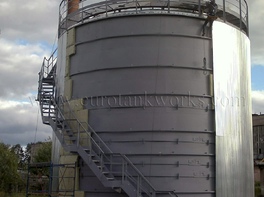Alternative Heat Insulation Methods
Block thermal insulation with protective metal cover
It is a quite often practice that we use plates of polyurethane foam or polyisocyanurate blocks, attached to the walls and/or the roof of a vertical tank for its heat insulation.
The insulation blocks are either attached to the tank by wire and fixing devices or fastened by gluing.
The heat insulation blocks are manufactured at special production plant and are made in the form, folded in the wall radius of the tank.
Tank thermal insulation by fluid polyurethane foam
This method implies that polyurethane foam is poured under the metal protective coat at the construction site.
It is important to carefully choose the type of the heat insulation material depending on the air temperature and humidity at the construction site, physical, technical and heating characteristics.
EuroTankWorks applies the polyurethane foam pouring-in technology that enables to avoid deformation of the metal protective coat. Pouring-in is carried out in several stages, after each previous layer is settled down. It is also necessary to
Thermal insulation by rigid polyurethane foam sputtering pay attention to the adhesion characteristics of the polyurethane foam to the material of tank framework and the coat covering.
It is essential to correctly plan the thickness of the insulating layer while using this method. This can be done based on operation requirements and the type of polyurethane foam. We use special sputtering equipment, ensuring the lamination with each layer’s thickness between 8 and 12 mm. For the sake of providing the quality of heat insulation the laminating regime should be kept in a way to let each previous layer finish the foaming process before the next layer is put, because there should be a certain time period for creation of vapor seal coating.
Thermal insulation by synthetic cellular rubber substance
The coils of cellular rubber are fastened to the walls and the roof of the tank by gluing. It is important to work the surface of the tank and to lay a ground. Our technology implies that the coils’ joints are glued with special heat-insulating strip.














